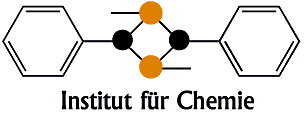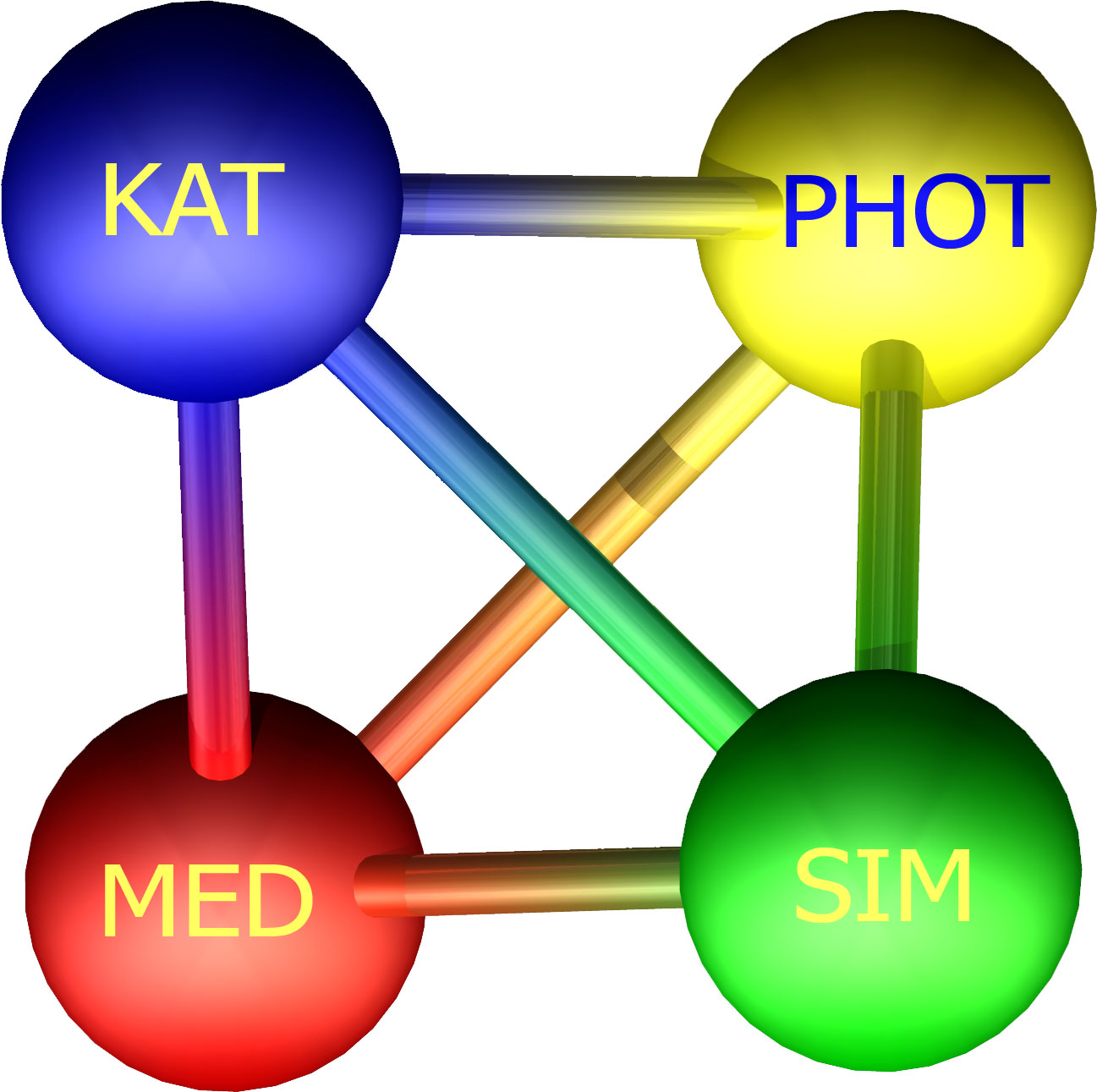Research
Our group focuses on the development and application of new and improved methods in Solid-state DNP-enhanced NMR spectroscopy on biomolecular systems. Especially the use of paramagnetic metal ions for internal DNP is a very promising field and our expertise on that field is unmatched worldwide.
Please return here periodically to check for updates on our progress!
DNP of RNA
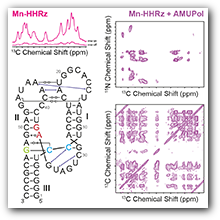
As the first and hitherto only group worldwide we are introducing dynamic nuclear polarization to ribonucleic acid (RNA) strucutral biology. RNA plays an important role in biological functions, not only as messenger of genetic information but also as regulator in gene expression. Spectroscopically RNA is highly demanding due to the occurence of only four unique building blocks, the nucleosides adenosin, guanosin, uridine and cytidine. This requires sophisticated NMR experiments with typically poor sensitivity which greatly benefit from DNP enhancement. Additionally RNA is often binding paramagnetic metal ions which can be used as polarizing agents for DNP as we have very recently demonstrated. We will investigate the site-selective DNP of RNA using endogenously bound metal ions for structural information. This is a subproject within collaborative research center 902 (Molecular mechnisms of RNA-based regulation).
Publications:
- P. Wenk, M. Kaushik, D. Richter, M. Vogel, B. Suess, and B. Corzilius: Dynamic Nuclear Polarization of Ribonucleic Acid with Endogenously Bound Manganese, J. Biomol. NMR 63, 97-109 (2015).
Investigation of Gd(III) DNP properties
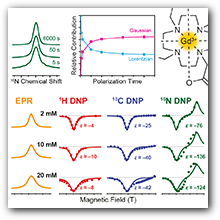
Gd-DOTA is an ideal model system to investigate DNP with high-spin metal ions. Due to their unique EPR properties these paramagnetic ions have peculiar properties for DNP. On the one hand, a small linewidth of the central EPR transition can allow for the direct DNP of nuclei with small gyromagnetic ratio such as 2H, 13C, and 15N by the solid effect. On the other hand, a significant zero-field splitting can lead to frequency matching between two electron spins and one nuclear spin for cross effect at large polarizing agent concentrations. Furthermore, we can investigate DNP-underlying nuclear spin diffusion by recording build-up dynamics in the bulk in combination with line shape analysis of the NMR signal. These data lead to a better understanding of the DNP mechanism at high field and potentially allow for improvement of structural information extraction by DNP.
Publications:
- B. Corzilius: Theory of solid effect and cross effect dynamic nuclear polarization with half-integer high-spin metal polarizing agents in rotating solids, Phys. Chem. Chem. Phys. 18, 27190-27204 (2016).
- M. Kaushik, T. Bahrenberg, T. V. Can, M. A. Caporini, R. Silvers, J. Heiliger, A. A. Smith, H. Schwalbe, R. G. Griffin, and B. Corzilius: Gd(III) and Mn(II) complexes for dynamic nuclear polarization: small molecular chelate polarizing agents and applications with site-directed spin labeling of proteins, Phys. Chem. Chem. Phys. 18, 27205-27218 (2016).
- M. Kaushik, M. Qi, A. Godt, and B. Corzilius: Bis-Gadolinium Complexes for Solid Effect and Cross Effect Dynamic Nuclear Polarization, Angew. Chem. 134, 4359-4363 (2017); Angew. Chem. Int. Ed. 56, 4295-4299 (2017).
DNP within Gd(III)-labeled proteins
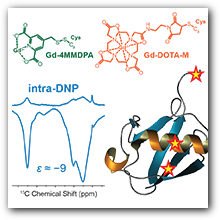
Proteins can be systematically labeled site-specific spin labeling using introduction of a single cystein mutation and subsequent chemical attachment of a metal ion binding tag. This allows us to investigate both DNP and paramagnetic effects such as relaxation enhancement and quenching/bleaching using Gd(III). We have achieved enhancement factors of up to 12 which -together with paramagnetic broadening and signal quenching- depend highly on the distance between electron spin tag and protein. This will aid us during the development of a quantitative method for distance measurement by DNP.
Publications:
- M. Kaushik, T. Bahrenberg, T. V. Can, M. A. Caporini, R. Silvers, J. Heiliger, A. A. Smith, H. Schwalbe, R. G. Griffin, and B. Corzilius: Gd(III) and Mn(II) complexes for dynamic nuclear polarization: small molecular chelate polarizing agents and applications with site-directed spin labeling of proteins, Phys. Chem. Chem. Phys. 18, 27205-27218 (2016).
DNP of paramagnetic proteins with exogenous radicals
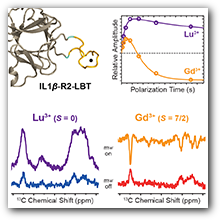
Many biomolecules contain paramagnetic sites which in many cases cannot be utilized for DNP and exogenous polarizig agents have to be added. However, the paramagnetic ions still interact with the nuclear spins as well as the radical polarizing agents. This leads to several effects and can lead to variations in build-up dynamics and DNP enhancement. Furthermore, the endogenous paramagnetic site causes additional quenching of NMR resonances with a distinct spatial correlation between electron and nuclear spin. We investigate several sample systems with either endogenous or artificial metal binding sites and utilize substitution of metal ions with different magnetic properties in order to systematically investigate these effects.
Publications:
- D. Daube, V. Aladin, J. Heiliger, J. J. Wittmann, D. Barthelmes, C. Bengs, H. Schwalbe, and B. Corzilius: Heternuclear Cross-relaxation under Solid-state Dynamic Nuclear Polarization, J. Am. Chem. Soc. 2016, doi:10.1021/jacs.6b08683.
DNP within crystalline samples
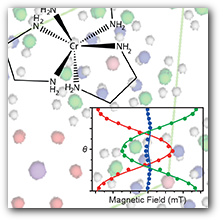
Crystalline compounds are not only insteresting from a materials science perspective but also offer unique possibilies for basic research. We have shown that a host lattice of Co(III) can be polarized by paramagnetic Cr(III) which has been doped into the lattice in small concentration. The investigation of unique spectral features in powdered samples or in single crystals allows invaluable insights into mechanistic aspects of DNP. This project is a collaboration with Robert G. Griffin (MIT) as well as Enrico Ravera and Claudio Luchinat (Florence).
Publications:
- B. Corzilius, V. K. Michaelis, S. A. Penzel, E. Ravera, A. A. Smith, C. Luchinat, and R. G. Griffin: Dynamic Nuclear Polarization of 1H, 13C, and 59Co in a Tris(ethylene-diamine)cobalt(III) Crystalline Lattice Doped with Cr(III), J. Am. Chem. Soc. 136, 11716-11727 (2014).
Past projects of Björn Corzilius at the Griffin group, MIT
Introducing paramagnetic metal complexes as polarizing agents for DNP
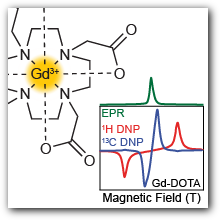
Paramagnetic metal systems, such as Gd(III) and Mn(II) containing chelate complexes open exciting possibilities as polarizing agents for solid effect DNP. Even though half-integer high-spin systems underlie a rather strong zero-field splitting, their narrow central transition can be evoked for solid effect DNP. We have demonstrated the basic principle of using these metal complexes for DNP and have tested three compounds: Gd-DOTA, Gd-DTPA, and Mn-DOTA. The impact of varying zero-field splitting induced by the ligand's geometry as well as metal hyperfine coupling has been elucidated, and the polarization build-up dynamics have been determined. Further experiments using different metals and environments are underway. This investigation lays the foundation for future experiments on DNP using endogenous paramagnetic metal sites in biomolecules or on polarizing paramagnetically doped materials. Collaboration with Ivano Bertini and Claudio Luchinat (Florence).
Publications:
- B. Corzilius, A. A. Smith, A. B. Barnes, C. Luchinat, I. Bertini, and R. G. Griffin: High-Field Dynamic Nuclear Polarization with High-Spin Transition Metal Ions, J. Am. Chem. Soc. 133, 5648-5651 (2011).
Systematic investigation of mechanisms and practical aspects of DNP
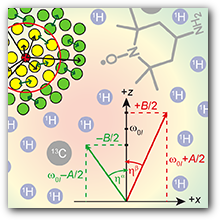
Understanding the effects of spin dynamics in isolated spin pairs and spin ensembles is crucial in order to develop novel methods and to optimize applied DNP. We have developed a model based on a quantum mechanical description of the solid effect and successfully generalized it under classical ensemble conditions. The model has been tested against experiments performed under static and under MAS conditions and allows us to interpret empirical observations such as the dependence of the achieved NMR enhancement and of the build-up kinetics on the applied microwave power. This helps us to understand the complicated processes occuring in parallel a large ensemble of thousands of electron and nuclear spins and make assumptions about the future development of solid effect DNP applications. Furthermore we have investigated signal quenching/bleaching as well as paramagnet-induced relaxation for several polarizing agents under practically relevant conditions. Finally, we have shown that the Overhauser effect is indeed active in insulating solids, and -together with solid effect- is playing an important role in applied high-field DNP.
Publications:
- B. Corzilius, A. A. Smith, and R. G. Griffin: Solid Effect in Magic Angle Spinning Dynamic Nuclear Polarization, J. Chem. Phys. 137, 054201 (2012).
- A. A. Smith, B. Corzilius, A. B. Barnes, T. Maly, and R. G. Griffin: Solid Effect Dynamic Nuclear Polarization and Polarization Pathways, J. Chem. Phys. 136, 015101 (2012).
- A. A. Smith, B. Corzilius, and R. G. Griffin: Observation of strongly forbidden transitions solid effect dynamic nuclear polarization transitions via electron-electron double resonance detected NMR, J. Chem. Phys. 139, 214201:1-6 (2013).
- B. Corzilius, L. B. Andreas, A. A. Smith, Q. Z. Ni, and R. G. Griffin: Paramagnet induced signal quenching in MAS-DNP experiments in frozen homogeneous solutions, J. Magn. Reson. 240, 113-123 (2014).
- T. V. Can, M. A. Caporini, F. Mentink-Vigier. B. Corzilius, J. J. Walish, M. Rosay, W. E. Maas, M. Baldus, S. Vega, T. M. Swager, and R. G. Griffin: Overhauser effects in insulating solids, J. Chem. Phys. 141, 064202:1-8 (2014).
- Q. Z. Ni, E. Markhasin, T. V. Can, B. Corzilius, K. O Tan, A. B. Barnes, E. Daviso, Y. Su, J. Herzfeld, and R. G. Griffin: Peptide and Protein Dynamics and Low-Temperature/DNP Magic Angle Spinning NMR, J. Phys. Chem. B 121, 4997-5006 (2017).
Development of novel and improved polarizing agents
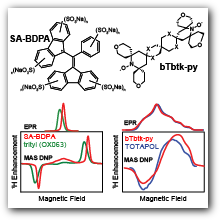
Developing optimized polarizing agents for varying DNP applications requires one to understand not only the DNP mechanism itself, but also the impact of several structural motifs on DNP parameters and spin relaxation times. Even if these effects were completely understood, synthesizing the ideal polarizing agent with sufficient solubility is a challenging task for organic chemists. Based on the success of the highly DNP efficient but limitedly soluble rigid bis-nitroxide bTbk, we have developed a route to synthesize the thioketal-derivative. Further substitiution of the sterically protecting methyl groups with tetrahydropyrans resulted in the rigid biradical bTbtk-py with sufficient solubility while still providing a 20% increased DNP effciency over TOTAPOL. Furthermore, we have introduced a water-soluble BDPA derivative, SA-BDPA, which outperforms trityl OX-063 and can be used as a modular compound in the development of future radicals or polarizing agents. Collaboration with Tim Swager (MIT) and Paul Tordo (Marseille).
Publications:
- E. L. Dane, B. Corzilius, E. Rizzato, P. Stocker, T. Maly, A. A. Smith, R. G. Griffin, O. Ouari, P. Tordo, and T. M. Swager: Rigid Orthogonal bis-TEMPO Biradicals with Improved Solubility for Dynamic Nuclear Polarization, J. Org. Chem. 77, 1789 (2012).
- M. K. Kiesewetter, B. Corzilius, A. A. Smith, R. G. Griffin, and T. M. Swager: Dynamic Nuclear Polarization with a Water-soluble Rigid Biradical, J. Am. Chem. Soc. 134, 4538 (2012).
- O. Haze, B. Corzilius, A. A. Smith, R. G. Griffin, and T. M. Swager: Water-Soluble Narrow-Line Radicals for Dynamic Nuclear Polarization, J. Am. Chem. Soc. 134, 14287 (2012).
- V. K. Michaelis, A. A. Smith, B. Corzilius, O. Haze, T. M. Swager, and R. G. Griffin: High Field 13C Dynamic Nuclear Polarization with a Radical Mixture, J. Am. Chem. Soc. 135, 2935 (2013).
- T.-C. Ong, M. L. Mak-Jurkauskas, J. J. Walish, V. K. Michaelis, B. Corzilius, A. A. Smith, A. M. Clausen, J. C. Cheetham, T. M. Swager, and R. G. Griffin: Solvent-Free Dynamic Nuclear Polarization of Amorphous and Crystalline Ortho-Terphenyl, J. Phys. Chem. B 117, 3040-3046 (2013).
Development of DNP instrumentation
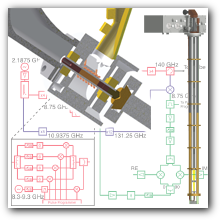
The development of custom-built DNP instrumentation is a crucial part of state-of-the-art research in this still young field. An integrated and highly versatile 5 T EPR/NMR/DNP spectrometer and a cryogenic DNP probe with a doubly-balanced NMR circuit and a double-resonant structure allow us to perform in-depth studies of basic DNP mechanisms. The spectrometer features a five-channel microwave circuitry operating at 140 GHz, allowing for sophisticated pulsed and double-resonance experiments. The EPR spectrometer is capable of complete cross-triggering with an attached NMR spectrometer, giving us the unique opportunity of performing cutting-edge DNP and ENDOR experiments. The development of state-of-the-art MAS-DNP probes for use in combination with a 140 GHz gyrotron is an unequally important tool for application of DNP to biological problems. Advanced microwave coupling technology, a three-channel rf-design as well as cryogenic sample eject allow for DNP-enhanced multi-dimensional NMR and efficient sample screening.
Publications:
- A. A. Smith, B. Corzilius, J. A. Bryant, R. DeRocher, P. Woskov, R. J. Temkin, and R. G. Griffin: A 140 GHz Pulsed EPR/212 MHz NMR Spectrometer for DNP Studies, J. Magn. Reson. 223, 170 (2012).
Investigation of novel methods: DNP on sedimented solutes (SedDNP)
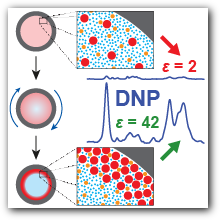
Sedimented solute DNP (SedDNP) allows us to perform DNP-enhanced MAS NMR on samples of soluble proteins or protein dispersions being sedimented either in-situ by MAS or ex-situ using an ultracentrifuge. We have investigated the properties of the sediment with respect to DNP conditions and found that the sediment features a glass-like environment. Effects of varying polarizing agent concentration have been investigated and the SedDNP method has been compared to "conventional" cryoprotecting DNP sample preparations. SedDNP is capable of suppressing background signals from natural-abundance solvent and of maximizing the sample filling factor for solid-state MAS-DNP since no cryoprotectant has to be added to the solution. Similar results can be achieved when -instead of being co-sedimented- the polarizing agent is binding to the protein. This is a collaboration with E. Ravera and C. Luchinat (Florence).
Publications:
- E. Ravera, B. Corzilius, V. K. Michaelis, C. Rosa, R. G. Griffin, C. Luchinat, and I. Bertini: Dynamic Nuclear Polarization on Sedimented Solutes, J. Am. Chem. Soc. 134, 1641 (2013).
- E. Ravera, B. Corzilius, V. K. Michaelis, C. Luchinat, R. G. Griffin, and I. Bertini: DNP-Enhanced MAS NMR of Bovine Serum Albumin Sediments and Solutions, J. Phys. Chem. B 118, 2957-2965 (2014).
Application of DNP to biological problems

DNP is a very powerful method to boost NMR sensitivity by up to several orders of magnitude and to allow for experiments to be performed which would be otherwise unfeasible. Still, each experiment and each system has to be individually approached using DNP by an experienced DNP spectroscopist. Investigations have to be carefully planned regarding sample preparation and NMR experiments. For example, we have been able to show that polarization spreads uniformly throughout the bR containing native purple membrane and have investigated several examples of line broadening at cryogenic temperatures. Additionally, using DNP-enhanced correlation spectroscopy we have been able to determine the external binding contacts of the inhibitor drug rimantadine to the influenza A proton transporter M2.
Publications:
- A. B. Barnes, B. Corzilius, M. L. Mak-Jurkauskas, L. B. Andreas, V. S. Bajaj, Y. Matsuki, M. L. Belenky, J. Lugtenburg, J. R. Sirigiri, R. J. Temkin, J. Herzfeld, and R. G. Griffin: Resolution and Polarization Distribution in Cryogenic DNP/MAS Experiments, Phys. Chem. Chem. Phys. 12, 5861 (2010).
- L. B. Andreas, A. B. Barnes, B. Corzilius, J. J. Chou, E. A. Miller, M. A. Caporini, M. M. Rosay, and R. G. Griffin: Dynamic Nuclear Polarization Study of Inhibitor Binding to the M218-20 Proton Transporter from Influenza A, Biochemistry 52, 2774-2782 (2013).
- K. K. Frederick, V. K. Michaelis, B. Corzilius, T.-C. Ong, A. Jacavone, R. G. Griffin, and S. Lindquist: Sensitivity enhanced NMR reveals alterations in protein structure by cellular environments, Cell 163, 620-628 (2015).


